
Francisco de Zurbarán was a Spanish painter. He is known primarily for his religious paintings depicting monks, nuns, and martyrs, and for his still-lifes. Zurbarán gained the nickname "Spanish Caravaggio", owing to the forceful use of chiaroscuro in which he excelled.

Jusepe de Ribera was a Spanish painter and printmaker. Ribera, Francisco de Zurbarán, Bartolomé Esteban Murillo, and the singular Diego Velázquez, are regarded as the major artists of Spanish Baroque painting. Referring to a series of Ribera exhibitions held in the late 20th century, Philippe de Montebello wrote "If Ribera's status as the undisputed protagonist of Neapolitan painting had ever been in doubt, it was no longer. Indeed, to many it seemed that Ribera emerged from these exhibitions as not simply the greatest Neapolitan artist of his age but one of the outstanding European masters of the seventeenth century." Jusepe de Ribera has also been referred to as José de Ribera, Josep de Ribera, and was called Lo Spagnoletto by his contemporaries and early historians.

A doubting Thomas is a skeptic who refuses to believe without direct personal experience – a reference to the Gospel of John's depiction of the Apostle Thomas, who, in John's account, refused to believe the resurrected Jesus had appeared to the ten other apostles until he could see and feel Jesus's crucifixion wounds.

Utrecht Caravaggism refers to the work of a group of artists who were from, or had studied in, the Dutch city of Utrecht, and during their stay in Rome during the early seventeenth century had become distinctly influenced by the art of Caravaggio. Upon their return to the Dutch Republic, they worked in a so-called Caravaggist style, which in turn influenced an earlier generation of local artists as well as artists in Flanders. The key figures in the movement were Hendrick ter Brugghen, Gerrit van Honthorst and Dirck van Baburen, who introduced Caravaggism into Utrecht painting around 1620. After 1630 the artists moved in other directions and the movement petered out. The Utrecht Caravaggisti painted predominantly history scenes and genre scenes executed in a realist style.

Hendrick Jansz ter Brugghen was a Dutch painter of genre scenes and religious subjects. He was one of the Dutch followers of Caravaggio – the so-called Utrecht Caravaggisti. Along with Gerrit van Hondhorst and Dirck van Baburen, Ter Brugghen was one of the most important Dutch painters to have been influenced by Caravaggio.

Christ Falling on the Way to Calvary, also known as Lo Spasimo or Il Spasimo di Sicilia, is a painting by the Italian High Renaissance painter Raphael, of c. 1514–16, now in the Museo del Prado in Madrid. It is an important work for the development of his style.
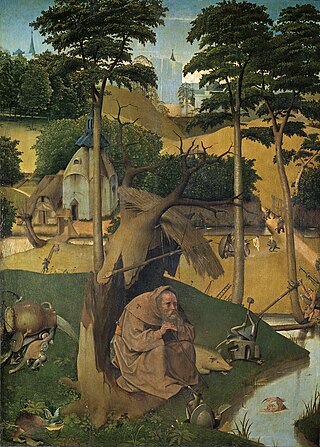
The Temptation of St. Anthony is a painting of disputed authorship, attributed to either the Early Netherlandish artist Hieronymus Bosch or a follower. It is now in the Museo del Prado, in Madrid.
A doubting Thomas is a skeptic who refuses to believe without direct personal experience.

Matthias Stom or Matthias Stomer was a Dutch, or possibly Flemish, painter who is only known for the works he produced during his residence in Italy. He was influenced by the work of non-Italian followers of Caravaggio in Italy, in particular his Dutch followers often referred to as the Utrecht Caravaggists, as well as by Jusepe de Ribera and Peter Paul Rubens. He did not share the other Northern Caravaggisti's preference for humorous, and sometimes scabrous, genre scenes and elaborate decorative allegories but favored stories from the bible instead. He worked in various locations in Italy where he enjoyed the patronage of religious institutions as well as prominent members of the nobility.

The Crucifixion with the Virgin and St John by Hendrick ter Brugghen is an oil painting, now in the Metropolitan Museum of Art in New York City. It was probably painted c. 1625 as an altarpiece for a Catholic schuilkerk, a "hidden church" or "church in the attic", in the Calvinist Dutch United Provinces, probably Utrecht. When discovered in a bombed out church in South Hackney, London in 1956, it was unknown, but by the time it appeared in Sotheby's salesroom in November of that year it was recognized as an important example of Utrecht Caravaggism. It was acquired by the museum in the sale.

The Wine of Saint Martin's Day is the largest painting by Pieter Bruegel the Elder. It is currently held in the Museo del Prado, Madrid, where it was identified as a Bruegel original in 2010. Like much of Bruegel's work it depicts peasant life, in this case a festival known as St. Martin's Day, which involves drinking the first wine of the season.

Jean Ducamps, Giovanni di Filippo del Campo or Giovanni del Campo, was a Flemish Baroque painter who spent most of his career in Italy where he enjoyed notoriety for his religious compositions, genre scenes and allegories. He worked in a style that was influenced by Caravaggio and is counted amongst the Northern Caravaggisti.

Saint Sebastian Tended by Irene is an oil-on-canvas painting by Hendrick ter Brugghen dated to 1625. Now in the Allen Memorial Art Museum of Oberlin, Ohio, the piece depicts the Roman Catholic subject of Saint Sebastian Tended by Saint Irene, after Irene of Rome and her maid rescued him following his attempted martyrdom by the Roman authorities. An exemplary piece of the Italianate Baroque tendency in Dutch Golden Age painting, the painting employs dramatic uses of light and skillful chiaroscuro to depict its religious subject, evidence of influence from Caravaggio and Ter Brugghen's fellow Utrecht Caravaggisti.
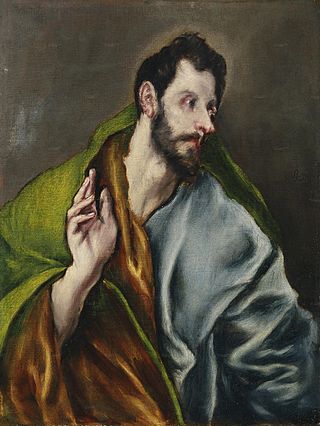
Saint Thomas the Apostle is a 1608–1614 painting of Thomas the Apostle by El Greco, now in the Museo del Prado.

The Finding of Moses is an early 1630s painting by Orazio Gentileschi. There are two versions, the prime version is in The National Gallery in London and the second is in Museo del Prado in Madrid.
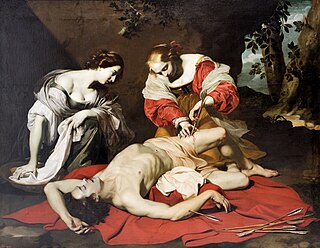
Saint Sebastian Tended by Saint Irene is an incident in the legends of Saint Sebastian and Saint Irene of Rome. It was not prominent in the hagiographical literature until the late Renaissance, and is hardly seen in art before then. As an artistic subject, normally in painting, it suddenly became popular from the 1610s, though found in predella scenes as early as the 15th century, and was most popular until about the 1670s.
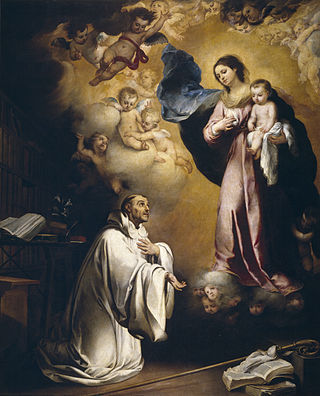
The Apparition of the Virgin to Saint Bernard is an oil on canvas painting by Spanish artist Bartolomé Esteban Murillo, created c. 1655, now held in the Museo del Prado in Madrid. The picture shows a miraculous Marian apparition to Catholic theologian Bernard of Clairvaux during his study time, what causes him to fall on his knees. His books and desk can be seen in the background.
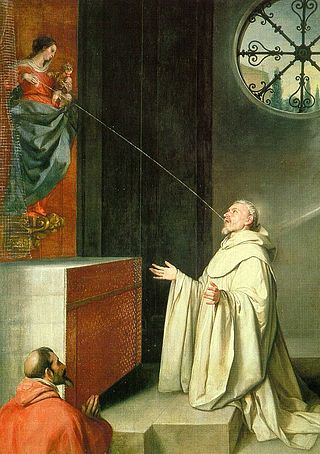
Saint Bernard and the Virgin is an oil on canvas painting by Spanish artist Alonso Cano, dated between 1645 and 1652, now held in the Museo del Prado in Madrid.

Christ embracing Saint Bernard is an oil on canvas painting by Spanish artist Francesc Ribalta, created between 1625 and 1627, now held in the Museo del Prado of Madrid. It has been described as "“one of the most famous examples of Spanish naturalism and one of the greatest expressions of contemporary mysticism".
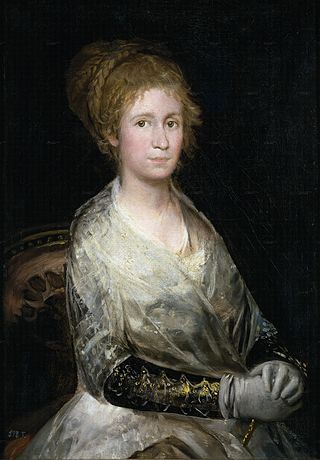
Josefa Bayeu or Leocadia Zorrilla is an oil painting by the Spanish painter Francisco Goya. It is currently housed in the Museo del Prado.



















